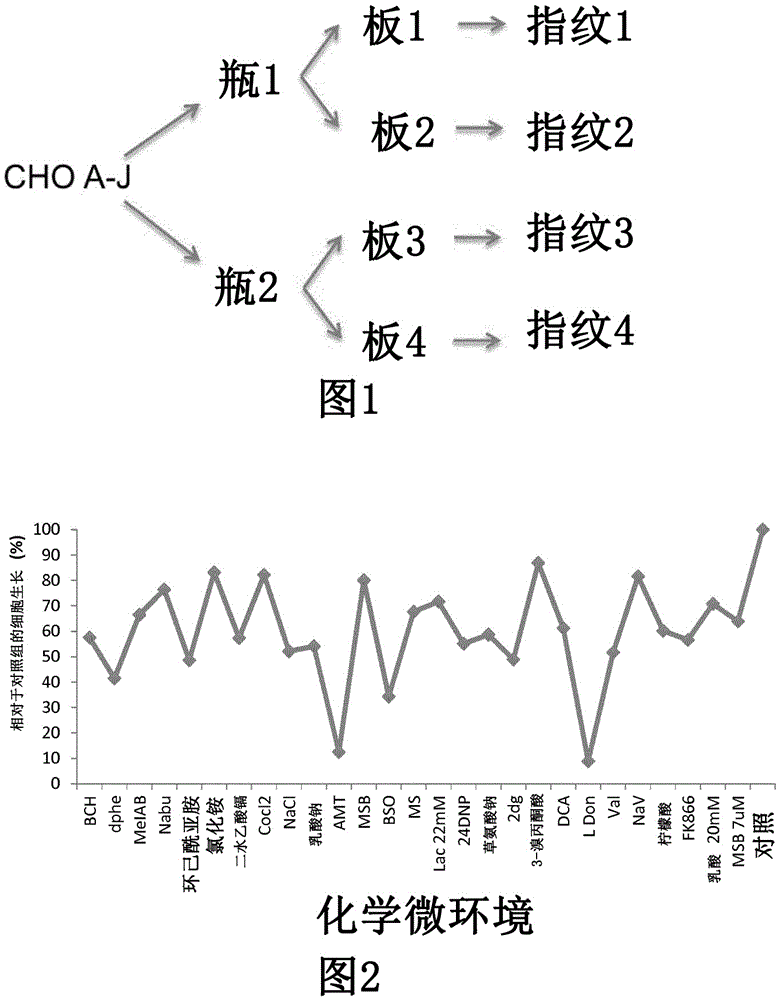A method of determining or predicting a characteristic of a cell
A cell and reference cell technology, which can be applied in the methods of supporting/immobilizing microorganisms, methods of stress-stimulating the growth of microorganisms, biochemical equipment and methods, etc., and can solve problems such as time-consuming and labor-intensive
- Summary
- Abstract
- Description
- Claims
- Application Information
AI Technical Summary
Problems solved by technology
Method used
Image
Examples
example 1
[0155] Example 1: Identifying Cells Using Stress Response Fingerprints
[0156] Each cell line (CHO-A to CHO-J) was revived from frozen dormancy in two vials. These cell lines were cultured in their recommended growth medium until the growth of each vial stabilized (approximately 4 consecutive subcultures after thawing). The two vials were cultured separately throughout. Using two vials, "bottle-to-vial" variation can be estimated. On day 3 after subculture, two vials of each cell line were inoculated on chemical plates ( figure 1 ). Essentially, each vial of cell lines was grown for 3 days on plates containing the above chemicals. Cells from each vial were seeded on 2 plates, ie 4 plates per cell line.
[0157] After this, the growth level of the cells in the plates was determined (ie in the presence and absence of the aforementioned chemicals) using the "PrestoBlue" assay described above. In this way, the cell-specific growth fingerprint of each CHO cell line can be...
example 2
[0179] Example 2 – Predicting fed-batch performance (IVCD50) of a panel of clonal cells
[0180] A set of 20 clonal cell lines with known fed-batch performance indicators (ie, IVCD50) were self-prepared. Each clonal cell line was grown for 3 days in multi-well plates containing the above chemicals. After this, the level of growth of the cells in the multi-well plate (ie in the presence and absence of the above chemical substances) was determined using the "" assay described above. This allows the identification of the cell-specific growth fingerprint of each clonal cell line. Here, the growth fingerprint was defined as the level of growth of cells in each microenvironment relative to the growth of cells in control wells (ie wells containing medium only).
[0181] An example of a typical growth fingerprint of a clone is figure 2 shown.
[0182] Using the information of these chemical fingerprints, a multivariate linear model was established with the response to each sing...
PUM
 Login to View More
Login to View More Abstract
Description
Claims
Application Information
 Login to View More
Login to View More - R&D
- Intellectual Property
- Life Sciences
- Materials
- Tech Scout
- Unparalleled Data Quality
- Higher Quality Content
- 60% Fewer Hallucinations
Browse by: Latest US Patents, China's latest patents, Technical Efficacy Thesaurus, Application Domain, Technology Topic, Popular Technical Reports.
© 2025 PatSnap. All rights reserved.Legal|Privacy policy|Modern Slavery Act Transparency Statement|Sitemap|About US| Contact US: help@patsnap.com



